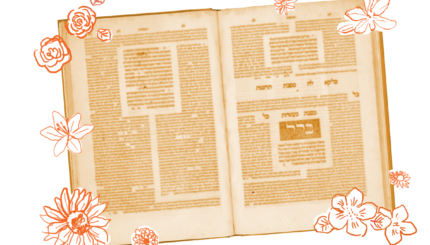In these accounts, the Ba’al Shem Tov, the founder of the modern Hasidic movement, and Rabbi Nachman of Bratslav, his great- grandson, teach (through the example of their own deaths) about the importance of facing one’s death, the centrality of prayer, the virtue of attending to another’s burial–and the possibility that death is not the end. These passages from Histalkut Hanefesh (“The Soul’s Leavetaking”) are excerpted from Jewish Reflections on Death, Jack Riemer ed. (Schocken Books).
The Ba’al Shem Tov
When the Baal Shem Tov fell ill shortly before his death, he would not take to bed. His body grew weak, his voice faint, and he would sit alone in his room meditating. On the eve of Shavuot, the last evening of his life, his intimates were gathered around him and he preached to them about the giving of the Torah. In the morning he requested that all of them gather together in his room and he taught them how they should care for his body after death. Afterward he asked for a siddur (prayer book) and said, “I wish to commune yet a while with Hashem Yitbarach (the [Divine] Name, may He be blessed).”
Afterward they heard him talking to someone and they inquired with whom he was speaking. He replied, “Do you not see the Angel of Death? He always flees from me, but now he has been given permission to come and flaps his wings and is full of joy.” Afterward all the men of the city gathered together to greet him on the holiday [of Shavuot] and he spoke words of Torah to them. Afterward he said, “Until now I have treated you with hesed (loving kindness). Now you must treat me with hesed. (The burial is considered the truest act of hesed, because there is no [possible] repayment.) He gave them a sign that at his death the two clocks in the house would stop.
While he was washing his hands, the large clock stopped and some of the men immediately stood in front of it so that the others should not see it. He said to them, “I am not worried about myself, for I know clearly that I shall go from this door and immediately I shall enter another door.” He sat down on his bed and told them to stand around him. He spoke words of Torah and ordered them to recite the verse [from Psalms]: “And let Thy graciousness, O Lord our God, be upon us; establish Thou also the work of our hands for us; Yea the work of our hands establish Thou it.” He lay down and sat up many times and prayed with great kavanah [intention] and devotion, until the syllables of his words could no longer be distinguished. He told them to cover him with blankets and began to shake and tremble as he used to do when he prayed the Silent Prayer [also known as the Amidah or “standing prayer”]. Then little by little he grew quiet. At that moment they saw that the small clock too had stopped. They waited and saw that he had died. He died on Shavuot, 1760.
Rabbi Nachman of Bratslav
Many months before the death of Rabbi Nachman of Bratslav–who already had achieved a rung so lofty that it seemed impossible to ascend higher while clothed with flesh–he said that he yearned to be free of his body. It was impossible for him to remain upon one rung for any length of time, for all of his days he had never stood still upon one rung even when he ascended to the highest point. He constantly yearned to go higher and higher. And so it was that a long time before he died he began to seek out a place of burial for himself, since for reasons he would not reveal, he did not wish to be buried in Bratslav.
At last he chose the city of Oman (where the Baal Shem, his grandfather, was born). He said that many deliverances could be brought about there and that there were many mysteries there which he could reveal to no one. When he settled in Oman, he had already grown very weak. On the Sabbath following Tisha b’Av, many Hasidim came to him and before they washed their hands for the meal, he said, “Why have you all come here? I do not know you at all, for I have now become a simple man.”
On the last night of his life, he spoke again about the soul. He commanded his disciples that immediately after he had died, while he yet lay upon the earth, they should take all of his writings that were in his desk and burn them. He insisted that they carry out his command. They stood about in confusion and despair and whispered among themselves while he was already preparing himself to depart. Then he said to them, “Perhaps you are speaking about your own concerns. But why do you worry that I depart from you? If these souls who know me not at all look to me for deliverance, how much the more so need you not fear.”
In the morning he gathered his tallit around him, prayed, took the etrog and lulav, completed saying the Hallel [Psalms 112-118, recited on the festivals] in a strong voice, and used the siddur of the Ari [Rabbi Isaac Luria, whose version of the prayerbook is used by many Hasidim], which rested upon his knees. Then he ordered them to dress him and wash him. And he took some wax and rubbed it between his fingers and meditated great thoughts, as was the custom of the great men; when they would meditate about something they would turn over in their fingers some wax. Thus at the last hour his mind was occupied with matters deep and most wonderful.
And when they saw that it was close to the end, they began to recite the verses which are said at the time of the death of the righteous. When it appeared that he had died, they began to cry out, “Our Rabbi–our Rabbi–with whom have you left us?” At that moment he stirred, raised his head and his wonderful face as if to say, “I am not leaving you.” Then he expired and was gathered to his people in holiness and in purity. He died on the eighteenth day of Tishri, 1810.
Sign up for a Journey Through Grief & Mourning: Whether you have lost a loved one recently or just want to learn the basics of Jewish mourning rituals, this 8-part email series will guide you through everything you need to know and help you feel supported and comforted at a difficult time.
Hasidic
Pronounced: khah-SID-ik, Origin: Hebrew, a stream within ultra-Orthodox Judaism that grew out of an 18th-century mystical revival movement.
siddur
Pronounced: SIDD-ur or seeDORE, Origin: Hebrew, prayerbook.
tallit
Pronounced: tah-LEET or TAH-liss, Origin: Hebrew, prayer shawl.
Torah
Pronunced: TORE-uh, Origin: Hebrew, the Five Books of Moses.


